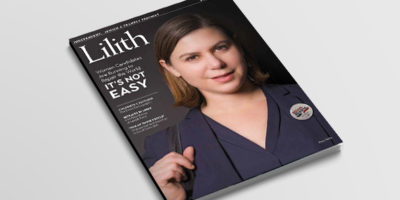She’s a Surrogate for Hidden Women’s Stories
IN FOCUS
“I want to show that there are so many ways to be a person,” says artist Shterna Goldbloom about her photography, which put at its center queer Jewish identities and challenges notions of what it means to be either, and both. Goldbloom’s photographs, many of them self-portraits, explore Jewish queerness with a double consciousness that reveals her history. Raised in Chicago’s Hasidic community, Goldbloom left that world at age 16, after her parents divorced and her mother came out as queer. “I was such a good student, everybody thought I would marry a rabbi. And I thought that too,” says Goldbloom about life before her family’s ostracism by their close-knit community.
Now, as a queer-identified Jewish woman who lives outside the bounds of the ultra-Orthodox world, Goldbloom makes intensely personal art that asks the age-old Jewish question: How do we exist in exile? Disconnected from the community through which we learned ritual, tradition, and meaning, how do we experience spirituality and connectedness? How can queer Jews do Judaism without throwing away the entire rule book?
Goldbloom’s answer is at once simple and tremendously powerful and provocative: choice. Queer Jews can—and must, and do—make choices about what and how and with whom to observe Judaism. She speaks devotedly about Shabbat as a ritual that she has found a way to both transform and preserve. And she honors the idea of choice and the process of decision-making, as well as real women’s choices, in her work. “If women in the Hasidic community don’t want to be in the spotlight, how can I tell their stories without their faces? This is why I chose self-portraiture, a style that allows me to be a surrogate for other women’s stories,” Goldbloom said on the website In-Geveb.org. “Just because people aren’t visible doesn’t mean they don’t hold power.”
Much of Goldbloom’s ongoing wrestling with what it means to be queer and ex-Orthodox is expressed through her photographs, which suggest a complicated longing for the comfort of Orthodox observance and aesthetic that coexists with a nuanced understanding of the ability of Orthodox Jewish communities to encompass queer identities.
Goldbloom’s photography focuses intently on issues of self-presentation, a constant theme of both Hasidic and queer life. In both communities, dress is used to signal group membership and to express core community values. Goldbloom’s photos juxtapose traditional Jewish aesthetics, including modest dress, sheitels (wigs), and tichels (headscarves) with androgynous dress, a half-shaved hairstyle, and piercings. Goldbloom’s is not the story of a queer Jew who escapes, rejects and resents a repressive religious environment. Hers is more complicated. She does not condemn Hasidic teachings and traditions; instead, she adapts, transforms, and interprets them in her photographs and in her spiritual life; she queers them.



